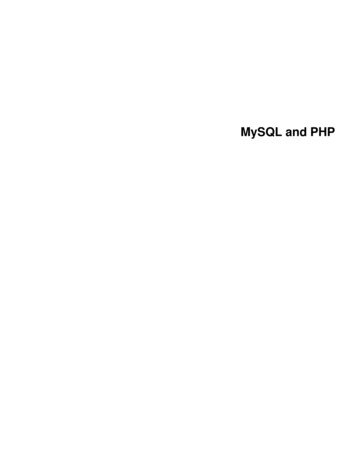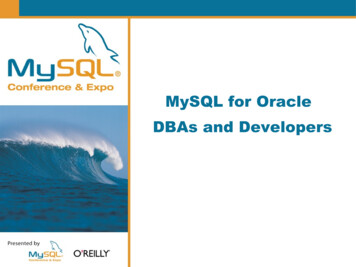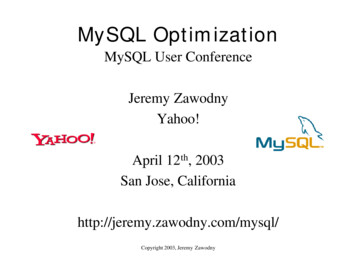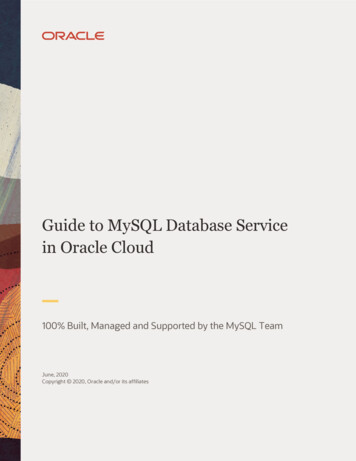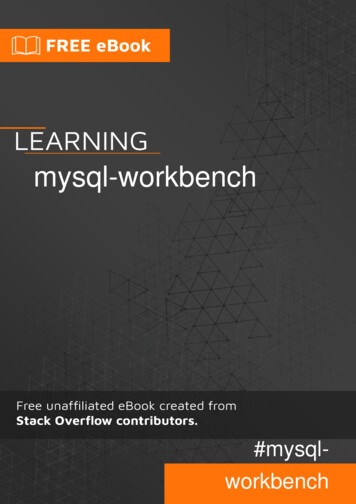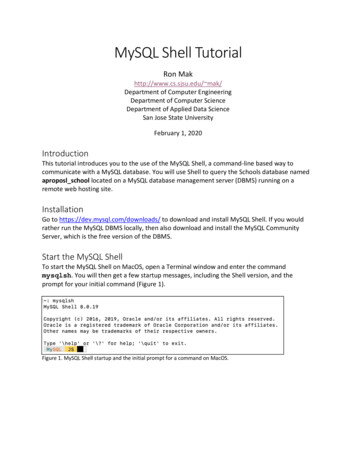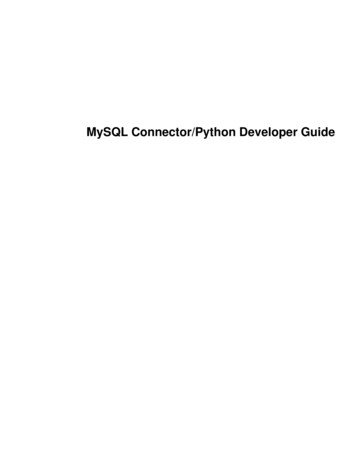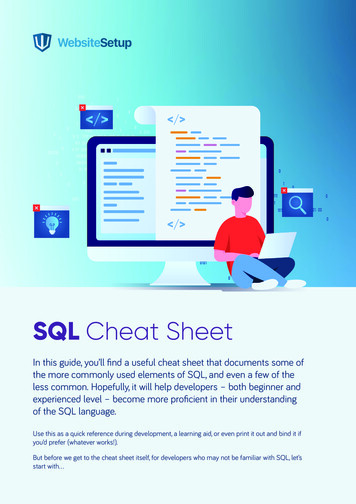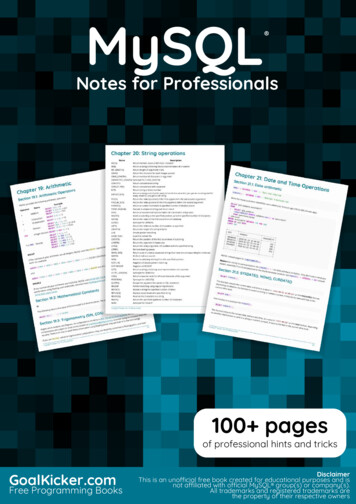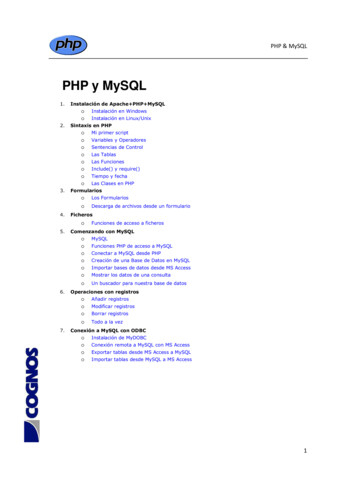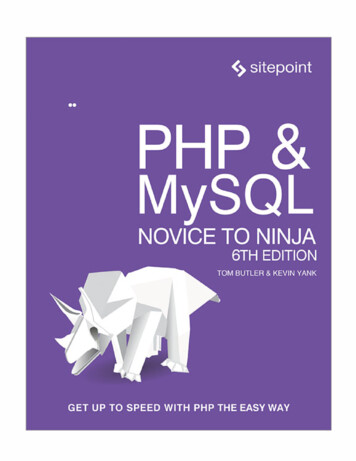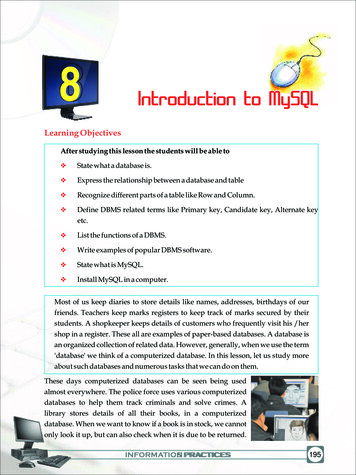
Transcription
8Introduction to MySQLLearning ObjectivesAfter studying this lesson the students will be able toState what a database is.vExpress the relationship between a database and tablevRecognize different parts of a table like Row and Column.vDefine DBMS related terms like Primary key, Candidate key, Alternate keyvetc.List the functions of a DBMS.vWrite examples of popular DBMS software.vState what is MySQL.vInstall MySQL in a computer.vMost of us keep diaries to store details like names, addresses, birthdays of ourfriends. Teachers keep marks registers to keep track of marks secured by theirstudents. A shopkeeper keeps details of customers who frequently visit his /hershop in a register. These all are examples of paper-based databases. A database isan organized collection of related data. However, generally, when we use the term'database' we think of a computerized database. In this lesson, let us study moreabout such databases and numerous tasks that we can do on them.These days computerized databases can be seen being usedalmost everywhere. The police force uses various computerizeddatabases to help them track criminals and solve crimes. Alibrary stores details of all their books, in a computerizeddatabase. When we want to know if a book is in stock, we cannotonly look it up, but can also check when it is due to be returned.INFORMATIONPRACTICESINFORMATICS PRACTICES195
Chapter-8Introduction to MySQLThe database also records details of all the borrowers, what books they currently haveborrowed and when they are due back.What is Database Management System(DBMS)?To create and maintain a database on a computer, we need a database program, called aDatabase management system, or DBMS. Database Management System is a softwarethat enables users to create and maintain databases. Examples of popular DBMSs areMySQL, PostgreSQL, Microsoft Access, Oracle, Microsoft SQL Server, DB2 and Sybase.A DBMS gives us tools to:vstore data in a structured way.vquery the database (that is, ask questions about the data)vsort and manipulate the data in the databasevvalidate the data entered and check for inconsistenciesvproduce flexible reports, both on screen and on paper, that make it easy tocomprehend the information stored in the database.Tables in a DatabaseRelational Databases store data or information in tables. A table is similar to aspreadsheet where data is stored in rows and columns. A table refers to a twodimensional representation of data using rows and columns. For example, consider thefollowing table named Customer with details about customers:ColumnTable: CustomerRowCustomer IDFirstNameLastNameAddressTelephone No101PrachiMehra145, Mahatma Avenue,Delhi9178908767102VinayAhlurkar76-A/32, Adarsh Nagar, 9278906351Delhi103VenuMagalamC-6, Kanthi Nagar,Delhi9323764561104NeezaAliB-6-B,Fateh Nagar,Meerut9143347330196INFORMATICS PRACTICES
Chapter-8Introduction to MySQLThe horizontal subset of the Table is known as a Row/Tuple. Each row represents arecord, which is a collection of data about a particular person, place or thing. The verticalsubset of the Table is known as a Column/Attribute. The term field is also often used forcolumn. Each column has a unique name and the content within it must be of the sametype.Relational DatabaseIn the database named Learner shown below, the data is organized into separate tables.Once the tables have been set up, a relationship can be created to link them together.Such a database that stores data in separate tables that are related through the use of acommon column is called a Relational database.Student tableStudentNameK.S. LakshmiAnkita MattaHimali ShahArushi GoelDatabase : LearnerStudentID8410092106Participant ngTennisGolfCricketSquashActivity RMATICS PRACTICES197
Chapter-8Introduction to MySQLRDBMS Terminology:Primary keyWhen you got admission in the school, you were given an Admission number. TheAdmission number assigned to you was not assigned to any other student of your school(it is unique). When patients go to a hospital, each patient is given a unique patientnumber. When you go to open an account in the bank, you are given a unique accountnumber. Admission number, Patient number, Account number are all examples ofPrimary key. A primary key is a field in a table that is unique for each record. Everydatabase table should have a column or a group of columns designated as the primarykey. The value this key holds should be unique for each record in the table.Some more examples of Primary key are: Accession Number of a Book in the Book table,Employee ID of an employee in the Employee Table, Item Code of an item in the Stocktable, Flight Number of a flight in the Flight Master Table, etc.The purpose of a primary key is to uniquely identify each record in a table.Candidate keyIn a table, there may be more than one field that uniquely identifies a record. All suchfields are called candidate keys. A Candidate key is an attribute (or set of attributes) thatuniquely identifies a row. A Primary Key is one of the candidate keys. A table may havemore than one candidate keys but definitely has one and only one primary key.Example: Consider the following Table, RollNo and Admission no both may be used touniquely identify each row in this Table, so both are candidate keys.Admission NoRollNoNameClassSecDues23011Simran Chadha11A2315012Ajay Kartik11B1516783Vanshay Chawla11A2070034Vibhor Madan11C15Alternate Key:Only one of the Candidate keys is selected as the primary key of a table. All other198INFORMATICS PRACTICES
Chapter-8Introduction to MySQLcandidate keys are called Alternate keys. In the above example, if we use one of thecandidate keys, say, Admission No as the Primary Key, the other Candidate Key RollNois the Alternate Key and vice-versa.Introduction to MySQL:The software required to manipulate relational databases is known as RelationalDatabase Management System (RDBMS) . Popular RDBMSs include MySQL, Oracle,Sybase, DB2, MS SQL Server.MySQL is a relational database management system (RDBMS). It is pronounced as "MySequel". MySQL was originally founded and developed in Sweden by David Axmark,Allan Larsson and Michael Widenius, who had worked together since the 1980s.Characteristics of MySQL:vMySQL is released under an open-source license so it is customizable. Itrequires no cost or payment for its usage.vMySQL has superior speed, is easy to use and is reliable.vMySQL uses a standard form of the well-known ANSI-SQL standards.vMySQL is a platform independent application which works on manyoperating systems like Windows, UNIX, LINUX etc. and has compatibilitywith many languages including JAVA , C , PHP, PERL, etc.vMySQL is an easy to install RDBMS and is capable of handling large data sets.Since MySQL is released under an open-source license, it does not require any cost orpayment for its usage. Any one can download this software from specific location onInternet. If you want to download, follow the following steps. The step for two mostpopular OS platform, Windows and Linux are discussed here.DOWNLOADING MySQL [Windows Environment]:Installation file for MySQL may be downloaded from the #downloads(Choose appropriate download link as per the operating system)INFORMATICS PRACTICES199
Chapter-8Introduction to MySQLClick on the "Download" buttonfor the Community Server andchoose from the list of supportedplatforms (i.e., operatingsystems that it will run on),which include 32-bit and 64-bitWindows, several differentLinux, Solaris, Mac OS X, and afew others.INSTALLING MySQL:After the installation file has finished downloading, double-click it, which begins theMySQL Setup Wizard.At the welcome dialog box, click the "Next" button.200INFORMATICS PRACTICES
Chapter-8Introduction to MySQLThe MySQL Setup Wizardallows us to choose theinstallation directory on thecomputer, and whether or not tohave optional componentsinstalled. In the "Setup Type"dialog box, choose "Typical"from the three options. MySQLwill be installed in the defaultdirectory, "C:\ProgramFiles\MySQL\MySQL Server.Click the "Next" button.Now it is ready to install MySQL's files. Click the "Install" button.After the Setup is complete, we should configure the new server.INFORMATICS PRACTICES201
Chapter-8Introduction to MySQLCONFIGURING MySQL:At the initial Server Instance Configuration Wizard dialog box, click the "Next" button.Keep selecting the default options provided in subsequent windows. If the configurationdoes not encounter any errors, then information will be prompted that the configurationfile was created, MySQL server was installed and started, and the security settingsapplied.Note: In the process of configuration of MySQL, a prompt for password will bedisplayed - Here you should enter a password and remember this password, as it will berequired each time to start MySQL202INFORMATICS PRACTICES
Chapter-8Introduction to MySQLTesting MySQL:Follow the steps to start MySQLStart Programs MySQL . MySQL Command Line ClientORGoto the folderC:\Program Files\MySQL\MySQL Server 5.1\binas the drive having MySQL][Assuming C:\ driveAnd Click on the fileMySQL.EXEMySQL will prompt a message to provide password (it requires the same passwordwhich was entered during the installation)Enter Password:****Welcome to the MySQL monitor. Commands end with ; or \g.Your MySQL connection id is 4Server version:(GPL)5.0.51a-community-nt MySQL Community EditionType 'help;' or '\h' for help. Type '\c' to clear the buffer.Mysql To exit from MySQL, type QUIT or EXITMysql QUITThe above steps ensure successful installation and configuration of MySQL databaseserver. Next time in the MySQL prompt, one can create and use databases, create tablesand execute SQL queries.Downloading MySQL [Linux Environment]:Installation of the binary version of MySQL, release 4.0.20, to run on Linux is as follows:Installation file for MySQL may be downloaded from the link:INFORMATICS PRACTICES203
Chapter-8Introduction to #downloads(Choose appropriate download link as per the desired operating system)Create MySQL User Account:# cd /usr/local# groupadd mysql# useradd -c "MySQL Software Owner" -g mysql mysql# passwd mysqlChanging password for user mysql.password: all authentication tokens updated successfully.Installing Binary Version:Unzip the files and change the directory to mysql# cd mysql# scripts/mysql install db --user mysqlPreparing db tablePreparing host tablePreparing user tablePreparing func table.The latest information about MySQL is available on the web athttp://www.mysql.comSupport MySQL by buying support/licenses athttps://order.mysql.com204INFORMATICS PRACTICES
Chapter-8Introduction to MySQLStart and Stop The Database Software:Starting the MySQL Database# su # cd /usr/local/mysql# bin/mysqld safe --user mysql &Starting mysqld daemon with databases from /usr/local/mysql/dataStopping the MySQL Database# su # cd /usr/local/mysql# bin/mysqladmin -u root shutdown040803 23:36:27 mysqld ended[1] Donebin/mysqld safe --user mysqlKnow moreVisit the following website to find a vast list of free and open source st of free and open source software packagesSummaryA database is an organised collection of data.vData is stored in a relational database in one or more tables.vA group of rows and columns forms a Table.vThe horizontal subset of a Table is known as a Row/Tuple.vThe vertical subset of a Table is known as a Column/Attribute.vA Candidate key is an attribute (or a set of attributes) that uniquely identifies avrow. A Primary Key is one of the candidate keys.Only one of the Candidate keys is selected as the primary key of a table. Allvother candidate keys are called Alternate keys.INFORMATICS PRACTICES205
Chapter-8Introduction to MySQLMultiple Choice Questions1.2.3.4.5.206A relation can have only one key and may have more than onekeys.a)Primary, Candidateb)Candidate, Alternatec)Candidate, Primaryd)Alternate, CandidateThe vertical subset of a table is known as:a)Tupleb)Rowc)Attributed)RelationIf software is released under open source, it means:a)It is expensive.b)Its source code is available to the user.c)It belongs to a company.d)It is a DBMS.Which of the following columns in a Student table can be used as the primarykey?a)Classb)Sectionc)First Named)Admission NoA tuple is also known as a .a)tableb)relationc)rowd)fieldINFORMATICS PRACTICES
Chapter-86.7.Introduction to MySQLAn attribute is also known as a .a)tableb)relationc)rowd)columnA field or a combination of fields in a table that has a unique value for each row iscalled:a)Candidate key.b)Foreign key.c)Main key.d)Alternate key.Exercises1.Answer the following questions:a)Define the following terms:i)Databaseii)Tableiii) Primary key2.iv)Candidate keyv)Alternate keyb)What is the relationship between a Database and a Table?c)What is DBMS? Write names of any two DBMSs.d)How is data organized in a table?e)What is a Primary key? What is its purpose in a table?f)What is MySQL?Distinguish between the following pairsa)Row and Columnb)Primary key and Candidate key.INFORMATICS PRACTICES207
MySQL is released under an open-source license so it is customizable. It requires no cost or payment for its usage. MySQL has superior speed, is easy to use and is reliable. MySQL uses a standard form of the well-known ANSI-SQL standards. MySQL
